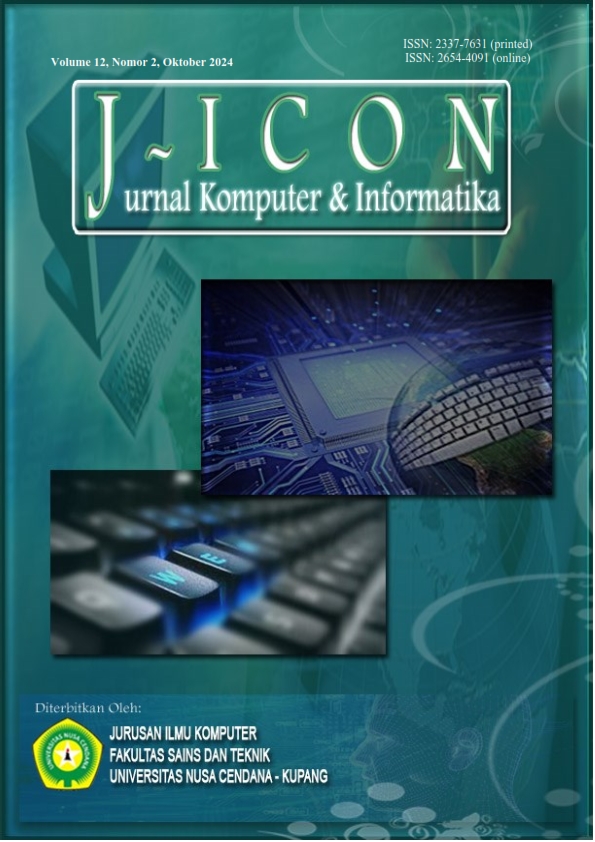Selection of Superior Rice Seeds by Applying Fuzzy Method and K-Means Clustering
Abstract
This study aims to develop a superior rice seed selection method using a Fuzzy and K-Means Clustering approach, with a case study in Kutai Kartanegara Regency, East Kalimantan Province, one of Indonesia's major rice-producing regions. The Fuzzy method is used to handle uncertainties in assessing seed characteristics, allowing each seed attribute (such as plant height, amylose content, grain weight, and yield) to have a membership value within specific categories. This fuzzification process provides flexibility in evaluating seed quality in stages, which is then converted through defuzzification to obtain a final score determining seed quality. K-Means Clustering plays a role in grouping seeds based on characteristics that have been assigned membership values. This algorithm divides seed data into several clusters, such as low, medium, and high quality, by calculating the distance between seed characteristics and each cluster's centroid. This iterative process yields seed groups with similar characteristics, simplifying recommendations for superior varieties. The evaluation was conducted using clustering accuracy metrics and silhouette score validation to ensure cluster cohesion and separation. The study results demonstrate that this method effectively identifies high-quality rice seeds with high accuracy. Recommended varieties include standard rice seeds like Mengkongga and Ciherang, as well as superior varieties like Inpari 32, Inpari 48, Padjajaran Agritan, Inpari IR Nutri Zinc, and Pamera, which are well-suited to Kutai Kartanegara’s specific conditions. Implementing this method is expected to assist farmers in selecting high-quality seeds, thereby supporting increased crop productivity in the study area.
Downloads
References
Tripathi Vikas, Verma Devvret, and Upadhyay Rajesh, “Prediction of Crop Yield in Precision Agriculture Using Machine Learning Methods,” Webology, vol. 18, no. 4, pp. 2244-2257. 2021, doi: 10.29121/web/v18i4/126.
J. Xu, J. Han, K. Xiong, and F. Nie, “Robust and Sparse Fuzzy K-Means Clustering,” Conference: International Joint Conference on Artificial Intelligence. July, 2016. [Online]. Available: https://www.researchgate.net/publication/314152643.
C.-T. Chang, J. Z. C. Lai, and M.-D. Jeng, “A Fuzzy K-means Clustering Algorithm Using Cluster Center Displacement,” Journal of Information Science and Engineering, vol. 27, no. 3, pp. 995-1009. 2011. [Online]. Available: https://api.semanticscholar.org/CorpusID:9861018.
M. Bakir and Ö. Atalik, “Application of Fuzzy AHP and Fuzzy MARCOS Approach for the Evaluation of E-Service Quality in the Airline Industry,” Decision Making: Applications in Management and Engineering, vol. 4, no. 1, pp. 127–152. Mar. 2021, doi: 10.31181/dmame2104127b.
T. M. Al-Shami, J. C. R. Alcantud, and A. Mhemdi, “New Generalization of Fuzzy Soft Sets: (a, b)-Fuzzy Soft Sets,” AIMS Mathematics, vol. 8, no. 2, pp. 2995–3025. 2023, doi: 10.3934/math.2023155.
V. Herlinda, D. Darwis, dan Darnoto, “Analisis Clustering Untuk Recredesialing Fasilitas Kesehatan Menggunakan Metode Fuzzy C-Means,” Jurnal Teknologi dan Sistem Informasi (JTSI), vol. 2, no. 2, pp. 94–99. 2021. [Online]. Available: https://jim.teknokrat.ac.id/index.php/sisteminformasi/article/viewFile/890/359.
M. Harahap, A. W. D. R. Zamili, M. A. Arvansyah, E. F. Saragih, S. Rajen, and A. M. Husein, “K-Means Clustering Algorithm Approach in Clustering Data on Cocoa Production Results in the Sumatra Region,” Jurnal RESTI (Rekayasa Sistem dan Teknologi Informasi), vol. 6, no. 6, pp. 905–910, Dec. 2022, doi: 10.29207/resti.v6i6.4199.
S. Dasgupta, N. Frost, M. Moshkovitz, and C. Rashtchian, “Explainable k-Means and k-Medians Clustering,” Proceedings of the 37th International Conference on Machine Learning. 2020. [Online]. Available: http://proceedings.mlr.press/v119/moshkovitz20a/moshkovitz20a.pdf
K. P. Sinaga and M. S. Yang, “Unsupervised K-means clustering algorithm,” IEEE Access, vol. 8, pp. 80716–80727, 2020, doi: 10.1109/ACCESS.2020.2988796.
R. I. Armianti, A. Fanany, O. Gaffar, A. Bramanto, W. Putra, and P. Korespondensi, “Penerapan K-Means Clustering Untuk Seleksi Frame Dominan Berbasis NTSC Pada Obyek Bergerak,” vol. 7, no. 4. Agustus, 2020, doi: 10.25126/jtiik.202072184.
Copyright (c) 2024 Bedi Suprapty, Rheo Malani, Achmad Fanany Onnilta Gaffar

This work is licensed under a Creative Commons Attribution 4.0 International License.
The author submitting the manuscript must understand and agree that if accepted for publication, authors retain copyright and grant the journal right of first publication with the work simultaneously licensed under a Creative Commons Attribution (CC-BY) 4.0 License that allows others to share the work with an acknowledgment of the work’s authorship and initial publication in this journal.
 Bedi Suprapty(1*)
Bedi Suprapty(1*)




